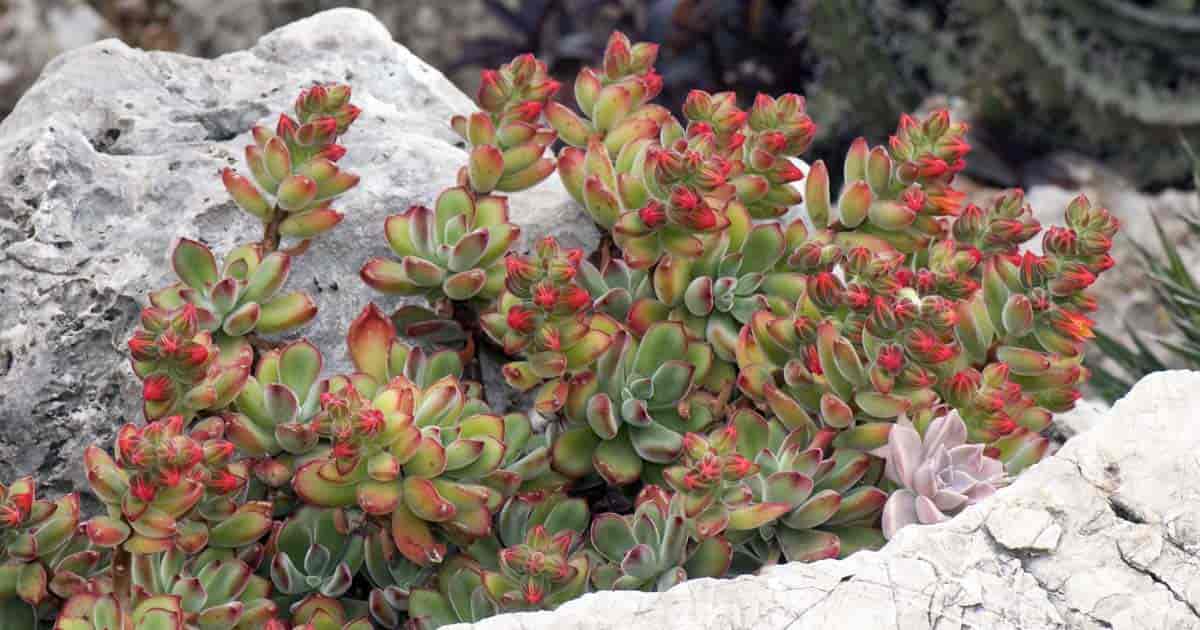Echeveria pulvinata (ech-eh-VER-ee-a pul-vin-AH-tuh) is a perennial succulent plant, from the Echeveria genus hailing from Oaxaca, Mexico. Tips on Echeveria succulent care.
The easy-to-grow plant is a member of the Crassulaceae family and like most succulents, this plant returns year after year in areas where it is winter hardy.

Common names include:
- Chenille Plant plush
- Ruby Slippers
- Plush Plant
- Ruby Blush
- Red Velvet
Echeveria Pulvinata Care
Size & Growth
The attractive small shrubby Echeveria pulvinata plant only grows about a foot high, with a spreading growth habit that can quickly sprawl many feet.
NOTE: A popular select cultivar is Echeveria pulvinata ‘Frosty’
Flowering & Fragrance
The orange-red flowers appear in late winter and continue into the spring.
First, 1′ foot long flower stalks appear. Next racemes of bell-shaped flowers grow.
As with all Echeveria plants, the flowers are attractive to pollinators and hummingbirds when planted outdoors.
Foliage
Succulent green leaves grow in small rosettes (no larger than 3″ or 4″ inches across) on long stems.
The green leaves of Echeveria pulvinata are covered thickly with white hairs (similar to Echeveria setosa) which help protect them from the harsh rays of the sun.
Environmental stresses such as high heat, low heat, or tremendous amounts of direct sunlight cause Ruby Blush Echeveria to develop tinges of red along the leaf margins.
Light Conditions & Temperature
These hardy succulents like lots of direct sunlight (full sun) and warm temperatures. Plush Chenille plant echeveria is winter hardy in USDA hardiness zones 9b-11b.
In lower hardiness zones these are tender succulents better suited for life indoors on a bright sunny windowsill.
Watering & Feeding Echeveria Pulvinata
- As with most drought tolerant cactus and succulents, water seldom but deeply.
- Allow the soil to dry completely before watering again.
- Take care not to allow water to sit on the rosettes as so may cause fungal disease and rot.
- Fertilize sparingly during the growing season using a standard cactus mix. Follow packaging instructions carefully.
- Do not fertilize during the winter months.
READ: Echeveria Watering: How Much and How Often?
Soil Mixture & Transplanting
Use a standard well-draining cactus mix or create your own potting soil using one part peat moss, one part loam, and two-part sand. The soil mix must have good drainage.
It’s best to repot at the end of the flowering season but before cold weather arrives. Allow the soil to dry out before repotting.
Remove Echeveria pulvinata from its pot and knock any old soil loose from the roots. If the cactus has any injuries, treat them with a fungicide.
Repot into a slightly larger container than the container the plant has come from.
Use fresh, clean succulent soil mix or porous soil. Allow the plant to settle in for about a week before watering.
Grooming & Maintenance
As your Ruby Slippers grow, remember to remove any dead leaves from its base. Leaving the dead leaves in place may cause fungal disease and rot.
Additionally, dead leaves create an excellent hiding place for pests.
How To Propagate Plush Plant Echeveria
As with all Echeveria varieties, propagating new plants from leaf cuttings and stem cuttings is the simplest and the most successful. Offsets from the mother plant can also be used.
Choose healthy leaf cuttings and place them on a tray of fresh succulent potting mix.
You may wish to place some plastic wrap or clear cover over the dish to help retain moisture until the leaf sprouts.
You can also propagate echeveria plants from stem cuttings or by removing small rosettes with an inch or so of stem attached.
Allow the rosette to dry in the open air for 3 to 5 days.
Plant it into a pot of slightly moist, well-draining cactus mix and simply treat it as an adult plant. It should take root and grow successfully within a week or so.
Plush Echeveria Plant Pests or Disease
As with most cactus and succulents, Echeverias are not subject to lots of disease and pests as long as it is well cared for.
If you do not overwater and keep it in well-draining soil with ample sunlight and warm temperatures, it should stay healthy and hardy.
Overwatered plants are subject to problems with rot and fungal diseases.
Plants weakened by poor conditions are subject to attacks by spider mites, fungus gnats, mealybugs, and scale.
DETAILS: Tips On Echeveria Succulent Pests and Diseases
Is Echeveria pulvinata considered toxic or poisonous to people, kids, and pets?
Like all Echeveria, this plant is non-toxic and safe for pets and people.
Is the plant considered invasive?
According to invasive.org, no species of echeveria is invasive in North America.
Uses For Echeveria Plush Pulvinata Plants
For many who grow the succulent Echeveria Pulvinata it soon becomes one of their favorite echeverias.
Red Velvet plants make lovely potted plants year-round indoors.
In areas where they are winter hardy, this particular species makes a nice groundcover as it tends to ramble quickly.

Echeveria pulvinata also make nice container plants on the porch or patio and moved indoors for winter in areas where they are not winter hardy.
Because of its rambling tendencies, Echeveria pulvinata can be quite attractive growing as a succulent hanging basket plant.
